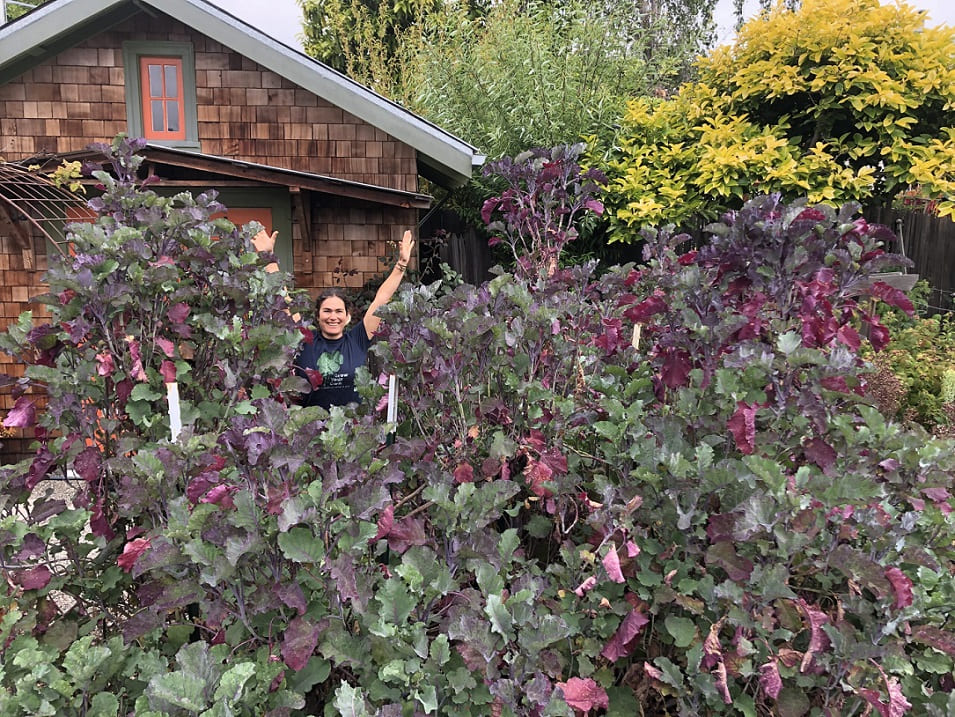Picture this: It’s the middle of January, snow is covering most of your garden, and you’re craving fresh, homegrown greens.
You bundle up, trudge outside, and harvest handfuls of sweet, purple-tinged leaves from a magnificent plant that looks more like a small tree than a vegetable. This isn’t a gardening fantasy—this is the reality of growing Purple Tree Collards.
Three winters ago, I was skeptical when my neighbor handed me what looked like a scraggly stick with a few leaves attached. “Trust me,” she said with a knowing smile, “this little cutting will change how you think about winter gardening.”
She was absolutely right. That modest cutting has grown into a 7-foot tall powerhouse that’s kept my family in fresh greens through every season since, requiring minimal care while delivering maximum nutrition.
If you’ve ever dreamed of having a reliable source of fresh greens that doesn’t require replanting every year, Purple Tree Collards might just be the game-changing perennial vegetable you’ve been searching for.
What Exactly Are Purple Tree Collards?
Purple Tree Collards (Brassica oleracea var. acephala) are the impressive cousins of regular collard greens, but with a few extraordinary differences that make them stand out in the perennial vegetable world.
Unlike their annual relatives, these remarkable plants can live anywhere from 5 to 20 years, growing into true “trees” that can reach heights of 6 to 12 feet.
The name perfectly describes their appearance: sturdy, woody stems that develop a tree-like structure topped with large, deeply purple-green leaves that cascade down like a leafy crown.
The purple coloration isn’t just for show—it intensifies during colder months, signaling the plant’s remarkable ability to not only survive but thrive in conditions that would kill most other vegetables.
What makes them truly special is their perennial nature. While most brassicas complete their life cycle in one or two years, Purple Tree Collards have somehow evolved (or been selected) to skip the flowering phase and continue producing leaves year after year.
This means once established, you’ll have a reliable source of nutritious greens without the annual hassle of replanting.
Why Purple Tree Collards Deserve a Spot in Every Garden
Year-Round Fresh Greens
The most compelling reason to grow Purple Tree Collards is their ability to provide fresh greens in every season.
During my first winter with these plants, I was amazed to discover that not only do they survive freezing temperatures, but the leaves actually become sweeter after frost. There’s something magical about harvesting fresh greens for a winter stew while everything else in the garden lies dormant.
Exceptional Nutritional Value
Like their collard cousins, Purple Tree Collards are nutritional powerhouses packed with vitamins A, C, and K, plus calcium, iron, and antioxidants.
The purple pigmentation indicates high levels of anthocyanins—the same beneficial compounds found in blueberries and red wine. When you’re eating these leaves, you’re essentially consuming a superfood that you grew yourself.
Incredibly Low Maintenance
Once established, these plants are remarkably self-sufficient. I’ve watched mine weather drought, floods, and temperature swings with minimal intervention. They’re like the reliable friend who’s always there when you need them—steady, dependable, and requiring very little from you in return.
Superior Flavor Profile
Many people expect collards to be tough and bitter, but Purple Tree Collards offer a pleasant surprise. The leaves have a mild, slightly sweet, nutty flavor that’s much more approachable than traditional collards.
Young leaves are tender enough for salads, while mature leaves excel in cooked dishes. The bitter compounds found in many brassicas are notably absent, making these accessible even to those who typically avoid greens.
Here’s How to Get Rid of Bitter Taste in Cucumbers With 4 Simple Techniques
Space-Efficient Vertical Growing
In our increasingly small garden spaces, Purple Tree Collards offer an elegant solution: they grow up instead of out. A single plant can produce an enormous amount of food while occupying just a few square feet of ground space. It’s like having a green smoothie bar growing in your backyard.
Understanding the Different Varieties
Not all Purple Tree Collards are created equal. Through my research and networking with other growers, I’ve learned there are several distinct varieties, each with unique characteristics:
- Purple Tree Collard (Classic)
The original and most common variety, featuring deep purple stems and leaves that intensify in color during cold weather. These are the sweetest-tasting variety and the most reliable performers across different climates.
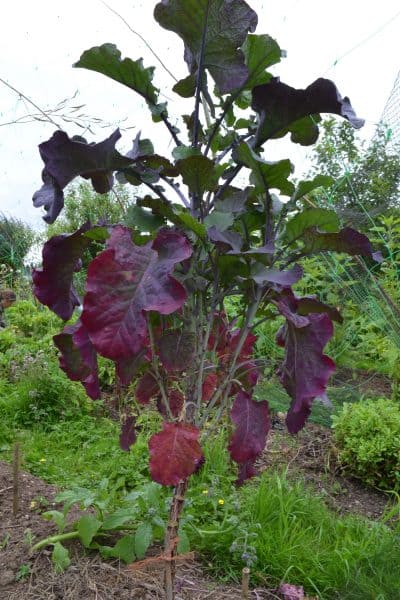
- Merritt Tree Collard
A vigorous variety with exceptionally large leaves—some reaching over 2 feet long and weighing more than half a pound each. They’re incredibly productive but have a tendency to flower more than other varieties.
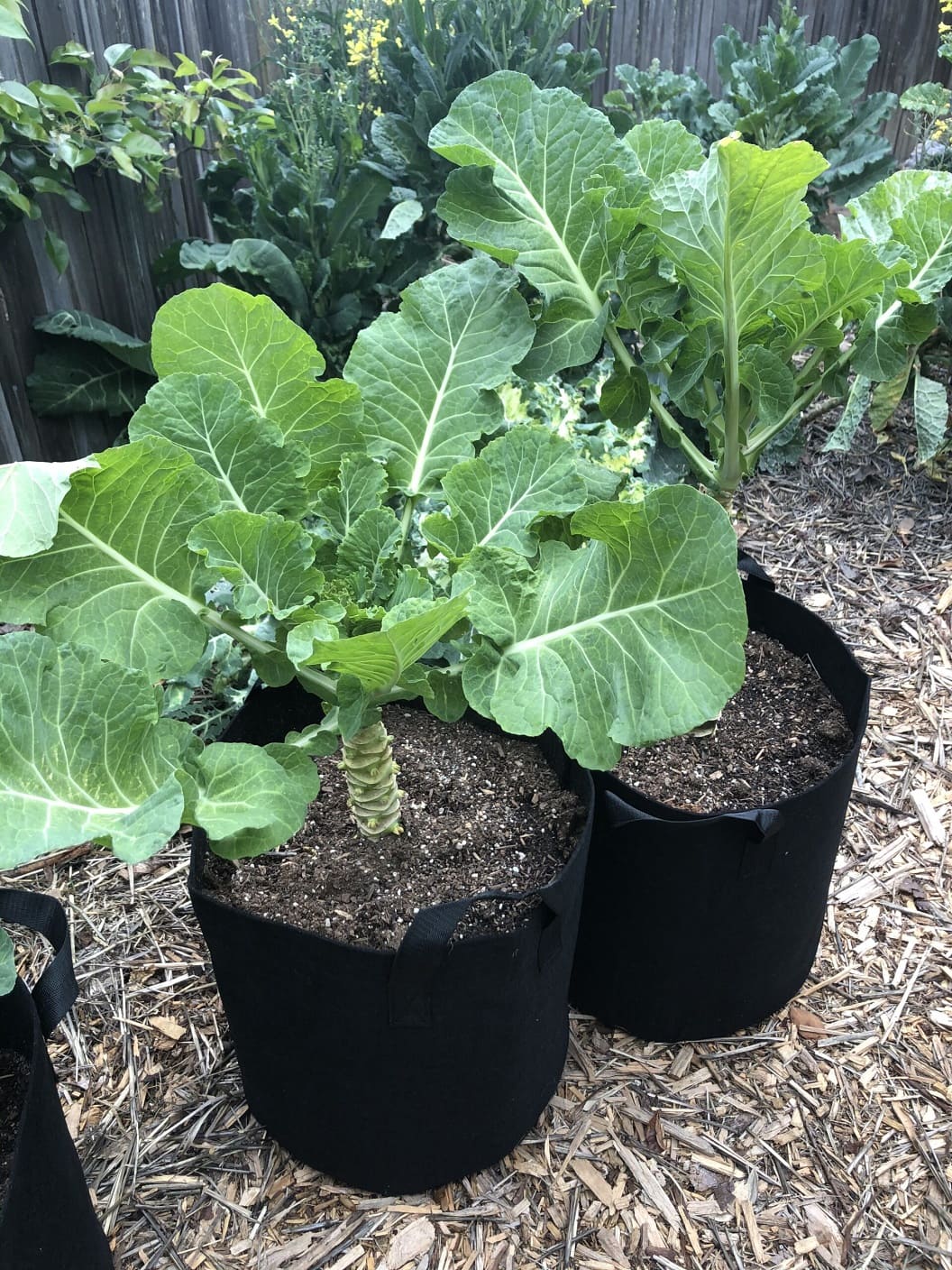
- Michigan Tree Collard
The cold-hardy champion of the tree collard world, reportedly surviving temperatures down to 0°F in zone 5. If you’re in a colder climate, this variety might be your ticket to year-round greens.
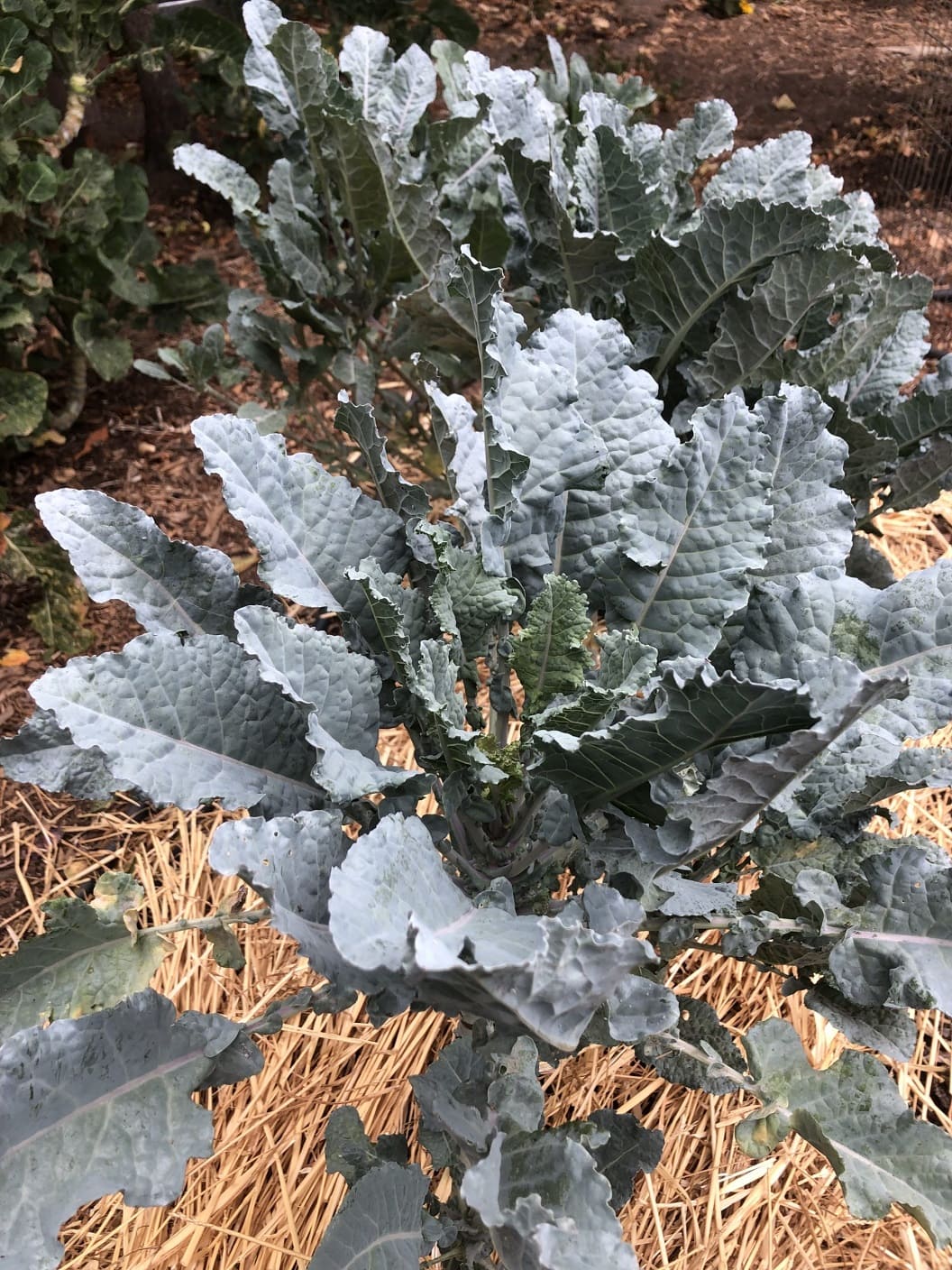
- Jolly Green Tree Collard
A fast-growing variety with smooth, bright green leaves similar to annual collards. They can reach 10 feet tall and have a milder flavor that’s perfect for those new to collards.
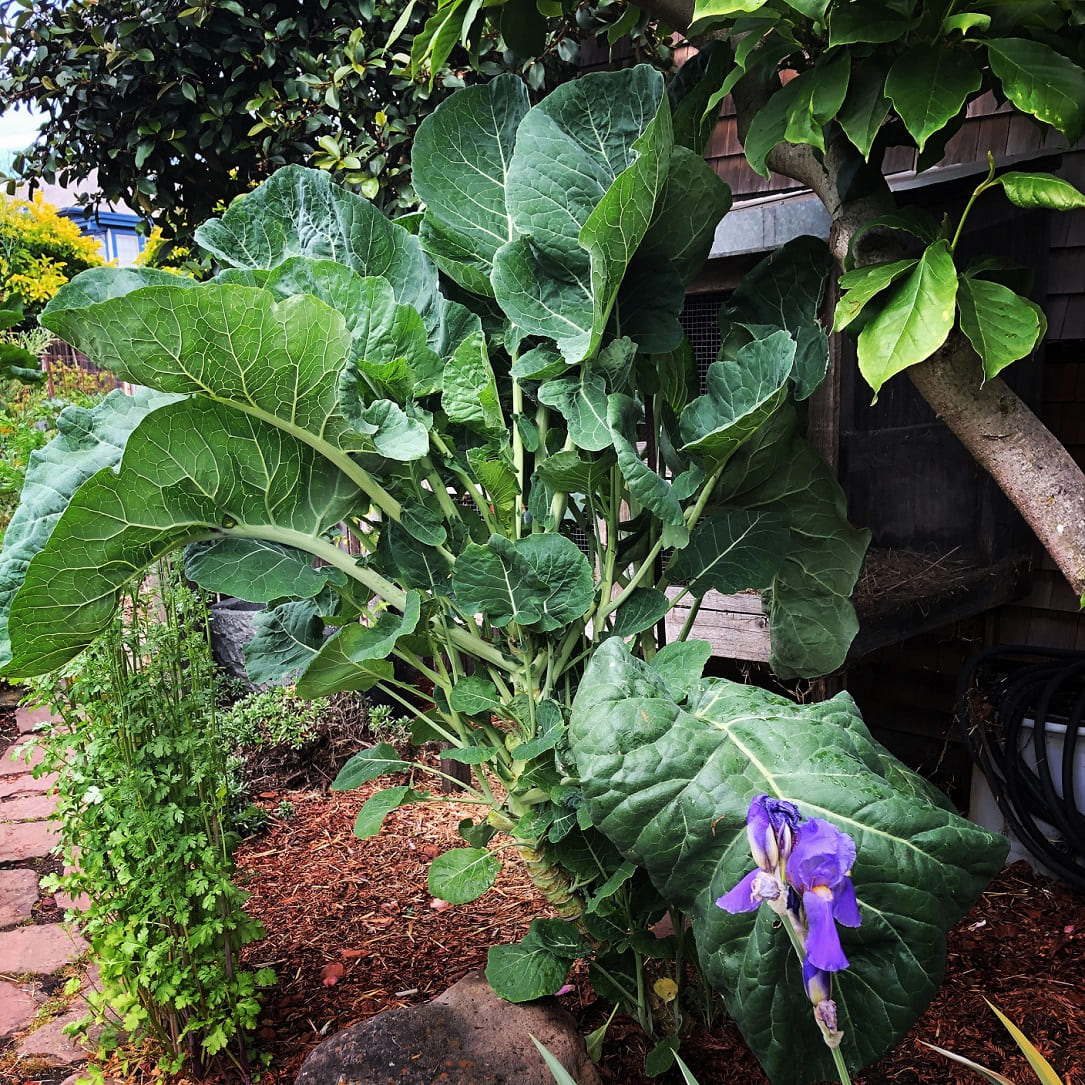
- Taunton Deane Kale
Technically a perennial kale but often grouped with tree collards, this English heirloom features silvery-green leaves with purple ribs and excellent cold tolerance.
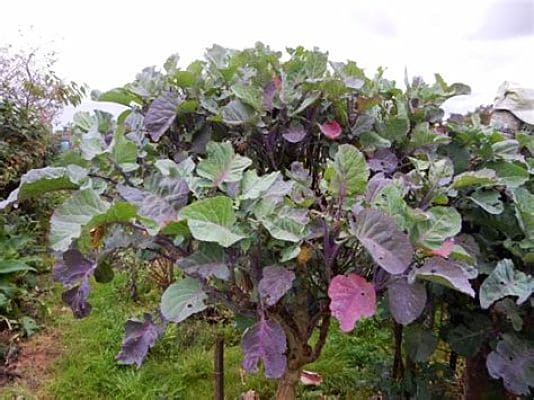
Getting Started: Sourcing Your Plants
Here’s where many beginning growers hit their first challenge: Purple Tree Collards are rarely found in regular nurseries, and they typically don’t grow true from seed. Most varieties are propagated exclusively through cuttings, which means you’ll need to source rooted cuttings or start your own from an existing plant.
Where to Find Purple Tree Collards
- Online Specialty Nurseries: Several nurseries specialize in perennial vegetables and offer rooted cuttings. Expect to pay $15-25 per cutting, which might seem steep, but remember you’re investing in a plant that could feed you for decades.
- Permaculture Communities: Local permaculture groups, plant swaps, and gardening forums are goldmines for finding established growers willing to share cuttings. This is how I got my start, and I’ve since passed along dozens of cuttings to other gardeners.
- Social Media Groups: Facebook groups, Reddit communities, and Instagram accounts dedicated to perennial vegetables often have members trading or selling cuttings.
- Seed Exchanges: While most tree collards don’t come true from seed, some gardeners experiment with breeding programs and occasionally offer seeds from interesting crosses.
Starting from Cuttings
If you’re lucky enough to get cuttings from an established plant, here’s how to give them the best start:
- Choose Quality Cuttings: Look for healthy, 6-8 inch stem pieces with several leaf nodes. Avoid woody, old growth or very soft, new growth.
- Prepare Immediately: Plant cuttings within 24 hours of taking them. If shipping is involved, keep them moist but not waterlogged during transit.
- Use the Right Soil: A well-draining potting mix in 1-gallon containers works best. Avoid garden soil, which can be too heavy and retain too much moisture.
- Provide Proper Conditions: Place in bright, indirect light and maintain consistent moisture without waterlogging. A greenhouse or protected outdoor area with 90% shade works perfectly.
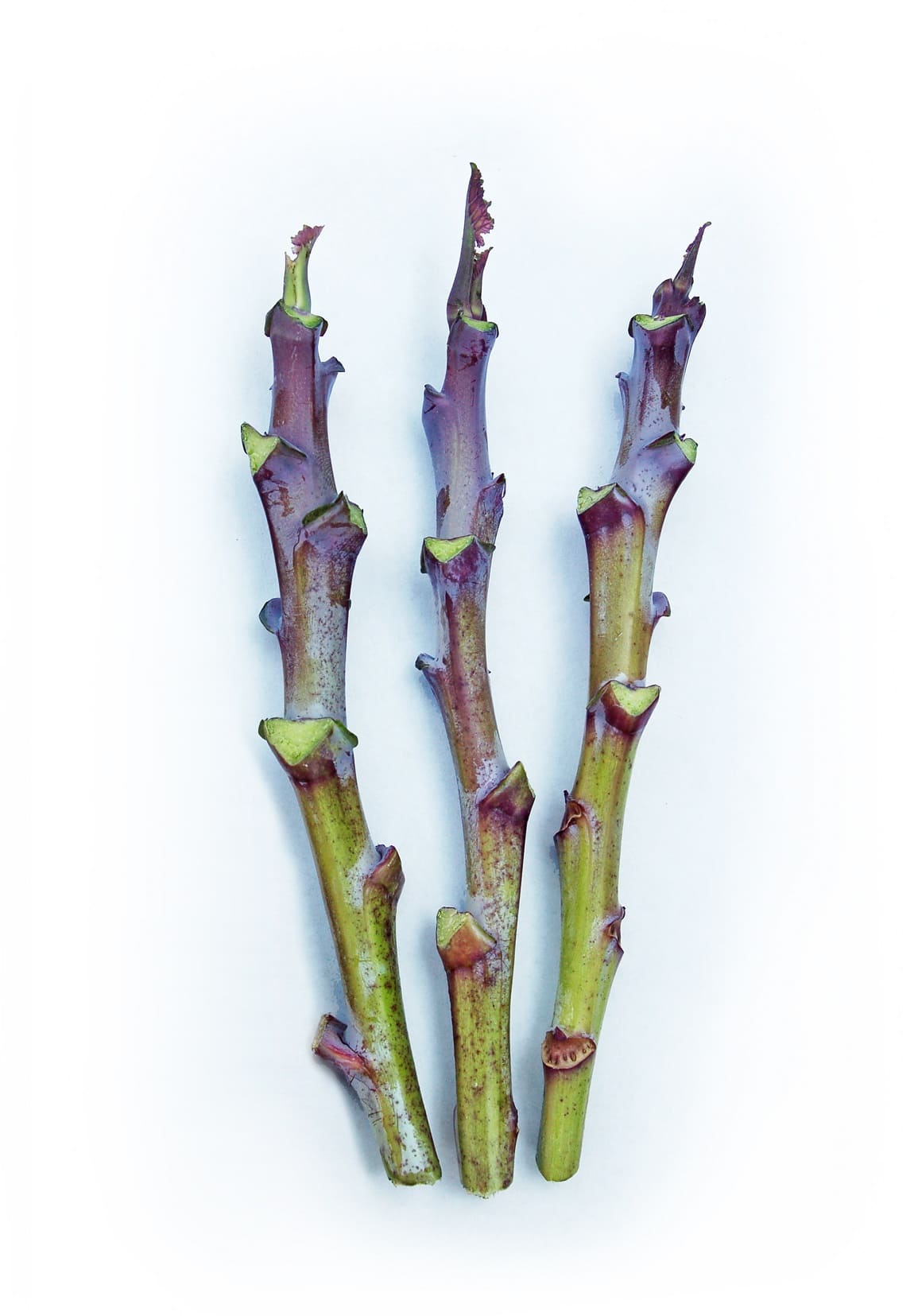
Here’s How to Propagate Plants in Water: Easy Step-by-Step Method
The Complete Growing Guide
Choosing the Perfect Location
Purple Tree Collards are surprisingly adaptable, but giving them ideal conditions will reward you with healthier, more productive plants. In my experience, the sweet spot is a location that receives full morning sun with some afternoon protection, especially in hotter climates.
I learned this lesson the hard way when I first planted mine in full, blazing afternoon sun. While they survived, the leaves were tougher and less flavorful compared to plants I later relocated to areas with gentler afternoon light. The ideal spot gets 6-8 hours of sunlight but avoids the harsh, hot afternoon rays that can stress the plants.
Consider the mature size when choosing your location. These plants will grow tall and wide, so avoid planting them where they’ll eventually shade out other crops or block important pathways. I made the mistake of planting one too close to my bedroom window—now I have to prune it regularly to maintain the view!
Explore 36 Shade-Loving Herbs and Vegetables That Grow With Less Sunlight
Soil Requirements
One of the delightful aspects of Purple Tree Collards is their soil adaptability. I’ve successfully grown them in heavy clay, sandy loam, and everything in between. However, the key requirement is drainage—these plants absolutely cannot tolerate waterlogged conditions.
- Optimal pH: Slightly alkaline soil (pH 6.5-7.5) produces the best-tasting leaves, though they’ll tolerate a wider range.
- Drainage: This cannot be overstated. If your soil tends to stay soggy, consider raised beds or container growing.
- Fertility: While they’ll grow in poor soil, adding compost or well-aged manure annually will significantly boost production and leaf quality.
- Soil Depth: These plants develop extensive root systems, so ensure at least 18 inches of workable soil depth.
Planting and Establishment
- Timing: In zones 8-9, plant anytime from early spring through fall. In colder zones, spring planting gives the best chance for establishment before winter.
- Spacing: Allow 3-4 feet between plants if growing multiple specimens. They need room to develop their full canopy.
- Planting Depth: Set rooted cuttings at the same depth they were growing in their pots. For unrooted cuttings, bury 2-3 nodes below soil level.
- Initial Care: Water consistently but not excessively during the first month. New plants are vulnerable to both drought stress and root rot.
Support and Training
This is where many growers struggle, and honestly, it took me a couple of seasons to figure out the best approach. Purple Tree Collards want to grow tall, but they also want to flop over once they reach a certain height and weight.
- Staking Early: Install a sturdy stake (metal T-posts work excellently) when the plant reaches about 2 feet tall. Waiting until they’re larger makes staking more difficult and risks damaging the root system.
- Pruning for Structure: You can influence the plant’s growth habit through strategic pruning. For a tree-like form, remove lower side shoots and maintain a central leader. For a bushier form, pinch the growing tip to encourage branching.
- Managing Height: Many growers maintain their plants at 4-6 feet by cutting them back annually. This keeps harvesting manageable and reduces the need for extensive support.
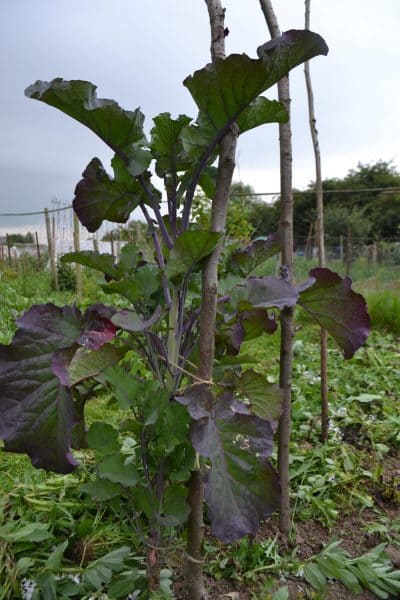
Watering and Fertilizing
Purple Tree Collards are surprisingly drought-tolerant once established, but consistent moisture produces better-quality leaves. I water mine deeply once or twice per week during dry periods, allowing the soil to dry slightly between waterings.
- Fertilizing: These heavy feeders benefit from monthly applications of balanced fertilizer during the growing season. I prefer liquid fish emulsion or compost tea, but any balanced organic fertilizer works well.
- Mulching: A 3-4 inch layer of organic mulch conserves moisture, suppresses weeds, and slowly feeds the plant as it decomposes.
Here’s How to Turn Fall Leaves into Soil Enriching Mulch For a Nutrient-Rich Garden
Climate Considerations and Hardiness
Understanding your local climate is crucial for Purple Tree Collard success. These plants are typically hardy in USDA zones 8-9, but with proper care, they can be grown in a wider range of conditions.
Cold Tolerance
Most varieties tolerate temperatures down to 15-20°F once established. However, I’ve learned that plant age matters significantly—older, well-established plants seem more cold-hardy than young ones.
During an unexpected cold snap that dropped temperatures to 12°F, my three-year-old plant sailed through unscathed while a younger plant showed significant damage.
Cold Protection Strategies:
- Plant in warm microclimates (south-facing walls, protected courtyards)
- Use frost cloth during extreme cold events
- Apply thick mulch around the base before winter
- Consider container growing in zones 7 and colder
Heat Tolerance
While these plants prefer moderate temperatures, established specimens handle heat surprisingly well. During last summer’s heat dome when temperatures hit 105°F for five consecutive days, my plants survived with extra watering and temporary shade cloth.
In hot climates, provide afternoon shade and ensure consistent moisture. The leaves become slightly more bitter in extreme heat, but they return to their sweet flavor once temperatures moderate.
Learn about Desert Gardening for Beginners: Growing Food & Plants in Extreme Heat
Humidity and Rainfall
Purple Tree Collards appreciate consistent moisture but can handle both humid and arid conditions. In areas with heavy rainfall, ensure excellent drainage to prevent root rot. In dry climates, mulching and regular irrigation become more critical.
Harvesting: Maximizing Your Year-Round Bounty
Learning to harvest Purple Tree Collards properly ensures continuous production and maintains plant health. Unlike annual crops that you harvest all at once, these plants require a more nuanced approach.
When to Start Harvesting
Begin harvesting once your plant is well-established and actively growing—typically 3-4 months after planting rooted cuttings. Young plants need time to develop strong root systems and adequate leaf mass before they can sustain regular harvesting.
I remember being overly eager with my first plant, harvesting too heavily too soon. The plant struggled and took nearly six months to recover. Now I practice patience, allowing new plants to develop substantial canopies before taking more than a few leaves.
Find out When and How to Harvest Vegetables for Peak Flavor: Timing and Tips for Every Crop
Harvesting Technique
- The 1/3 Rule: Never harvest more than one-third of the plant’s total leaf mass at once. This ensures the plant can continue photosynthesis and maintain vigor.
- Selective Picking: Choose the largest, most mature leaves first, leaving younger leaves to continue growing. This mimics natural leaf drop and encourages continued production.
- Clean Cuts: Use sharp, clean scissors or pruning shears to make clean cuts. Tearing leaves can damage the plant and create entry points for disease.
- Timing: Harvest in the morning after dew has dried but before the heat of the day. Leaves are crisper and more flavorful at this time.
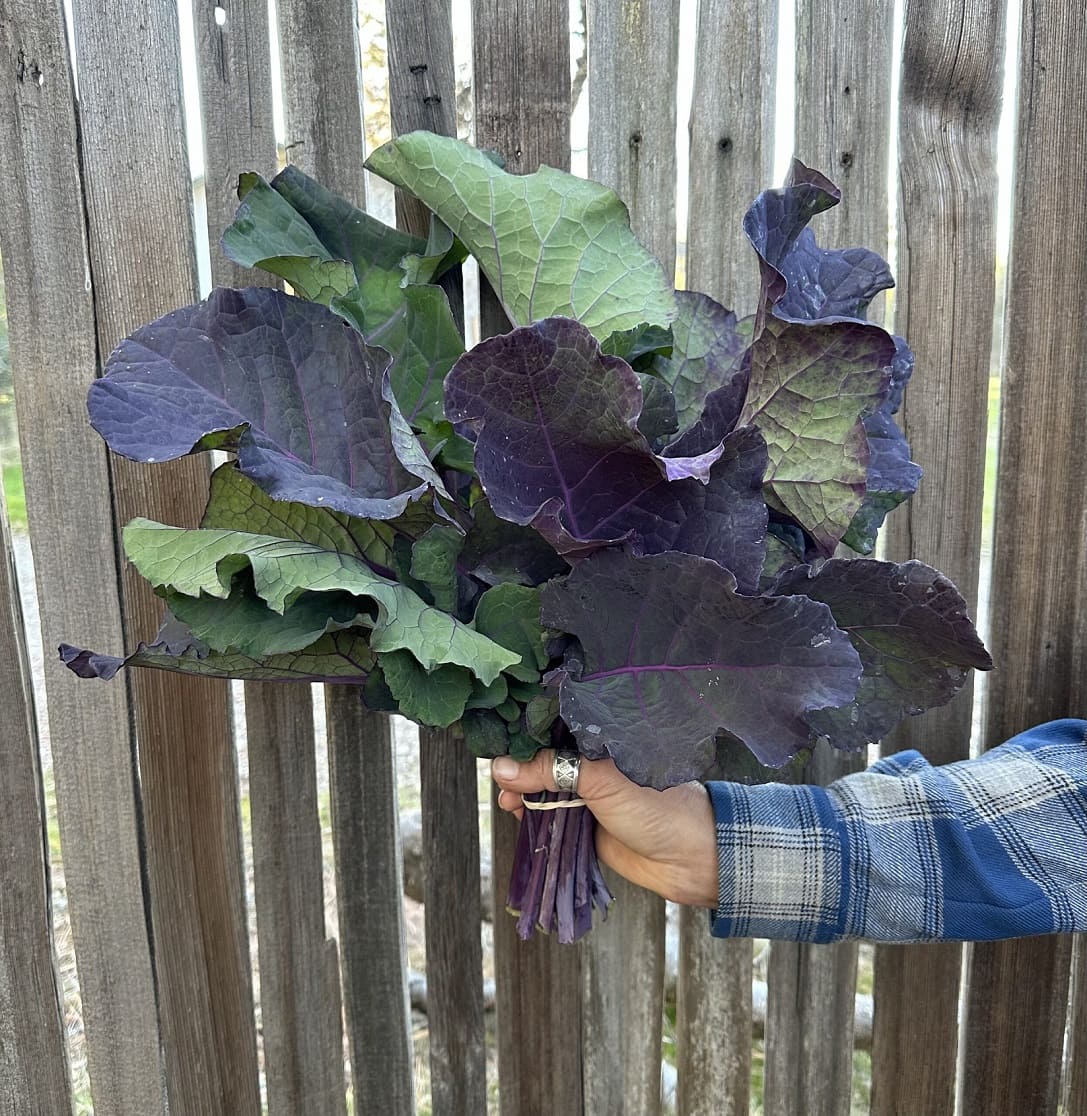
Seasonal Variations
- Spring: The sweetest, most tender leaves of the year. Perfect for salads and light cooking.
- Summer: Leaves may become slightly more bitter in extreme heat. Still excellent for cooking, and chickens love them if you find them too strong.
- Fall: Flavor improves as temperatures cool. Leaves begin developing deeper purple coloration.
- Winter: Peak flavor period! Frost actually improves the taste, making leaves incredibly sweet and tender.
Culinary Adventures: From Garden to Table
One of the greatest joys of growing Purple Tree Collards is discovering the incredible versatility of your harvest. These leaves can be used in virtually any dish where you’d use kale, spinach, or traditional collards—but with superior flavor and texture.
Fresh Applications
- Raw in Salads: Young, tender leaves make excellent salad greens. I like to massage them lightly with a bit of olive oil and lemon juice to soften the texture.
- Green Smoothies: The mild flavor makes these perfect for smoothies. Unlike kale, they don’t overpower other ingredients.
- Wraps: Large leaves make excellent wraps for sandwich fillings or grain salads.
Cooked Preparations
- Sautéed Greens: My go-to weeknight side dish. Simply sauté with garlic, olive oil, and a splash of broth.
- Soups and Stews: Add chopped leaves to soups in the last 10 minutes of cooking. They hold their texture well and add incredible nutrition.
- “Kale” Chips: The slightly tougher texture of Purple Tree Collards makes superior chips that stay crispy longer than traditional kale chips.
- Braised Dishes: Perfect for long, slow cooking methods that traditional collards are famous for.
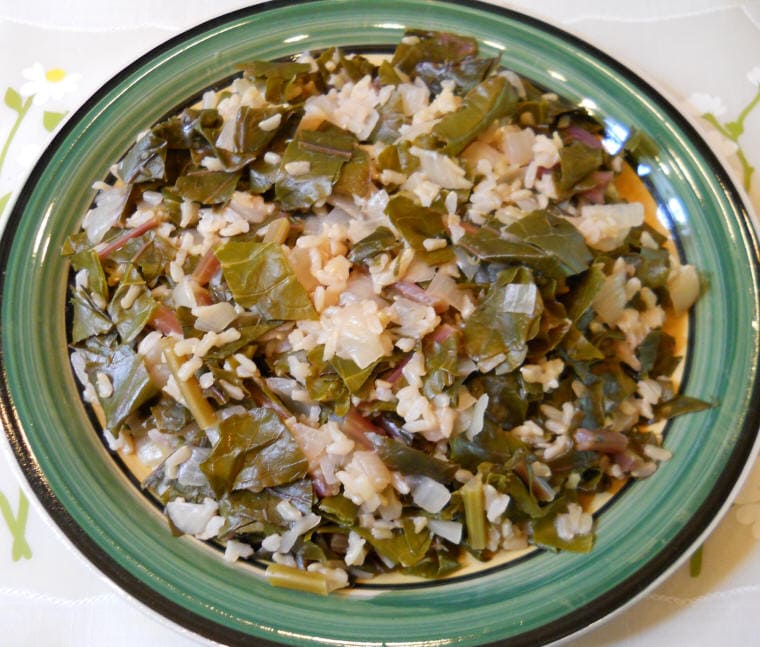
Preservation Methods
- Freezing: Blanch leaves for 2 minutes, shock in ice water, drain well, and freeze in bags. Perfect for winter soups.
- Dehydrating: Make your own greens powder for smoothies or seasoning.
- Fermentation: Incorporate into sauerkraut or kimchi for probiotic benefits.
Propagation: Sharing the Wealth
Once your Purple Tree Collards are established, propagation becomes an exciting opportunity to expand your collection and share with fellow gardeners. This is where the true magic of these plants reveals itself—their ability to clone themselves from simple cuttings.
When to Take Cuttings
The best time for propagation is during active growing periods in spring and fall. I avoid taking cuttings during extreme heat or cold, when the parent plant is stressed.
Signs of Readiness:
- Parent plant is at least one year old and well-established
- Active new growth with healthy, vibrant leaves
- No signs of stress, disease, or pest problems
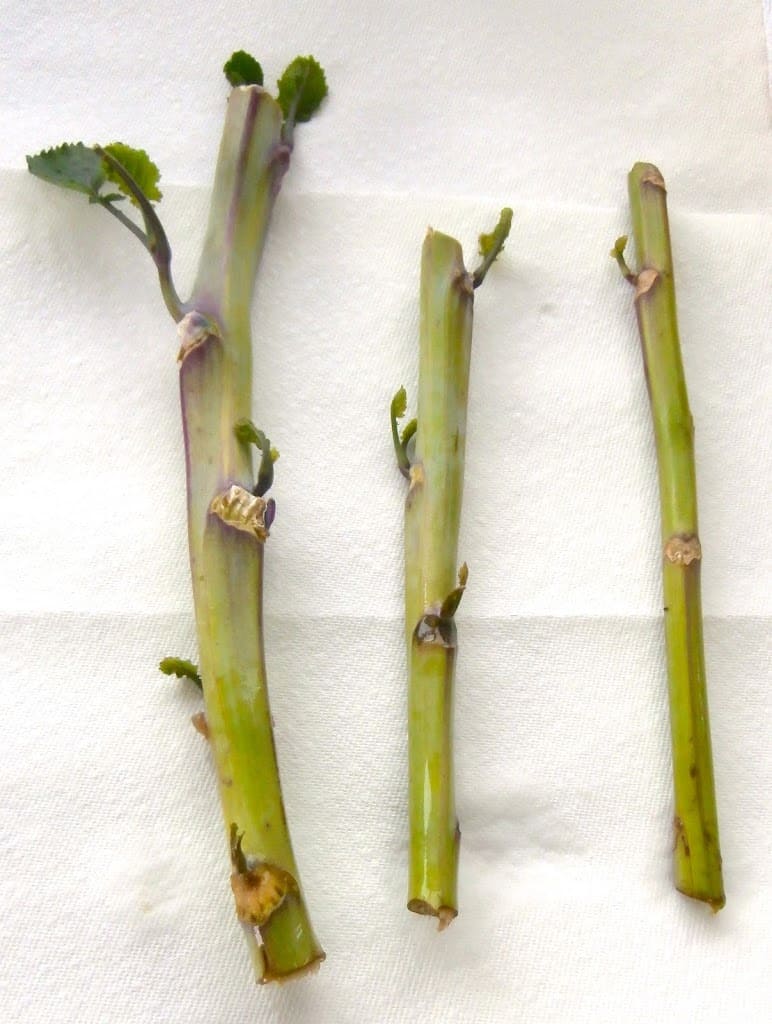
Step-by-Step Propagation
- Select Healthy Shoots: Choose 6-8 inch shoots with several leaf nodes and healthy leaves.
- Make Clean Cuts: Use sharp, sterile pruning shears to cut just below a leaf node.
- Prepare Cuttings: Remove all but the top 1-2 small leaves to reduce moisture loss.
- Optional Rooting Hormone: While not necessary, rooting hormone can improve success rates.
- Plant in Containers: Use 1-gallon pots with well-draining potting mix.
- Provide Proper Environment: Place in bright, indirect light with consistent moisture.
- Monitor Progress: Roots typically develop in 4-6 weeks. Look for new growth as a sign of successful rooting.
Troubleshooting Propagation Issues
- Cutting Failure: Usually caused by too much direct sun, inconsistent watering, or poor drainage.
- Slow Rooting: Normal in cooler weather. Be patient and maintain consistent care.
- Rot: Often indicates overwatering or poor drainage. Start fresh with better conditions.
Common Challenges and Solutions
Even these resilient plants face occasional challenges. Learning to identify and address problems early ensures long-term success.
Pest Management
- Cabbage Worms: The classic brassica pest. Hand-picking works for small infestations, while Bt (Bacillus thuringiensis) provides organic control for larger problems.
- Aphids: Common in spring and fall. Strong water sprays or insecticidal soap usually resolve issues quickly.
- Flea Beetles: Small holes in leaves indicate flea beetle activity. Row covers during vulnerable periods provide effective protection.
- Slugs and Snails: Particularly problematic on young plants. Copper barriers, beer traps, or organic iron phosphate baits work well.
Disease Prevention
- Clubroot: A soil-borne disease affecting all brassicas. Ensure good drainage and avoid planting in areas with a history of clubroot.
- Powdery Mildew: Usually indicates poor air circulation. Proper spacing and pruning can prevent most issues.
- Black Rot: Characterized by V-shaped lesions on leaves. Remove affected foliage immediately and ensure good sanitation.
Environmental Stress
- Leaf Drop: Normal during establishment or stress periods. Maintain consistent care and be patient.
- Poor Growth: Usually indicates soil issues, insufficient light, or nutrient deficiencies.
- Premature Flowering: Some varieties are more prone to flowering than others. Remove flower buds promptly to maintain leaf production.
Frequently Asked Questions
- Q: How long do Purple Tree Collards really live?
A: With proper care, these plants can live 5-20 years. I know gardeners with plants over a decade old that are still producing heavily. The key is good growing conditions and protection from extreme weather.
- Q: Can I grow Purple Tree Collards in containers?
A: Absolutely! Use large containers (at least 20 gallons) and expect to prune more frequently to manage size. Container growing also allows you to move plants indoors in colder climates.
- Q: Why won’t my Purple Tree Collards turn purple?
A: Purple coloration develops in response to cold temperatures and stress. Plants grown in consistently warm conditions may remain more green. This doesn’t affect flavor or nutritional value.
- Q: Do Purple Tree Collards need cross-pollination?
A: No. These plants rarely flower, and when they do, the flowers should be removed to maintain leaf production. All propagation is done through cuttings.
- Q: How much should I expect to harvest from one plant?
A: A mature plant can easily provide 2-3 pounds of greens per month during peak growing season. Over a year, expect 15-25 pounds of harvest from a well-maintained plant.
Seasonal Care Calendar
- Spring: Take cuttings, fertilize established plants, prune for shape, watch for early pests.
- Summer: Maintain consistent watering, provide shade in extreme heat, monitor for stress.
- Fall: Resume normal fertilizing, prepare for winter protection in borderline zones, take final cuttings.
- Winter: Harvest prime-quality leaves, protect from extreme cold, plan for spring expansion.
Building a Purple Tree Collard Community
One of the most rewarding aspects of growing Purple Tree Collards is becoming part of a passionate community of gardeners who share knowledge, cuttings, and recipes. These plants have a way of connecting people—perhaps because they represent something rare and special in our world of annual vegetables.
Start by connecting with local gardening groups, permaculture organizations, and online communities. Share your experiences, ask questions, and don’t be shy about offering cuttings once your plants are established. I’ve made wonderful friendships through purple tree collard connections, trading not just plants but stories, recipes, and gardening wisdom.
The Bigger Picture: Sustainable Gardening
Purple Tree Collards represent something larger than just another vegetable in the garden. They embody the principles of sustainable, perennial agriculture—plants that produce food year after year with minimal inputs, building soil health and sequestering carbon while feeding our families.
In a world increasingly concerned with food security and environmental impact, perennial vegetables like Purple Tree Collards offer a glimpse into a more sustainable future. They require no annual tilling, minimal fertilizer inputs, and provide habitat for beneficial insects while producing nutrient-dense food.
Conclusion: Your Purple Tree Collard Journey Begins
As I write this, I can see my original Purple Tree Collard through my office window—now a magnificent 8-foot specimen that has provided countless meals, dozens of cuttings for fellow gardeners, and endless satisfaction. What started as a skeptical acceptance of a neighbor’s gift has become one of my most treasured garden plants.
Purple Tree Collards aren’t just vegetables; they’re living investments in your family’s health, your garden’s diversity, and your connection to the cycles of nature. They ask for very little yet give abundantly, year after year.
In our fast-paced world of annual crops and constant replanting, there’s something deeply satisfying about nurturing a plant that will feed you for decades.
Whether you’re a seasoned gardener looking to add something special to your collection or a beginner seeking a forgiving entry into homegrown food production, Purple Tree Collards deserve serious consideration.
They’ll teach you patience as they establish, reward you with consistent harvests, and connect you to a community of gardeners who understand that some of the best things in life require time to develop.
The question isn’t whether you can afford to try Purple Tree Collards—it’s whether you can afford not to. In a world where we’re increasingly disconnected from our food sources, these remarkable plants offer a path back to abundance, sustainability, and the simple joy of harvesting dinner from your own backyard.
Your Purple Tree Collard journey is waiting to begin. That first small cutting might look humble, but give it time, care, and patience. In a few years, you’ll be the one with a knowing smile, sharing cuttings with skeptical neighbors and watching their eyes light up when they taste their first frost-sweetened Purple Tree Collard leaf.
The investment you make today in Purple Tree Collards isn’t just in a plant—it’s in a more sustainable, delicious, and connected future. Your taste buds, your health, and your garden will thank you for years to come.
